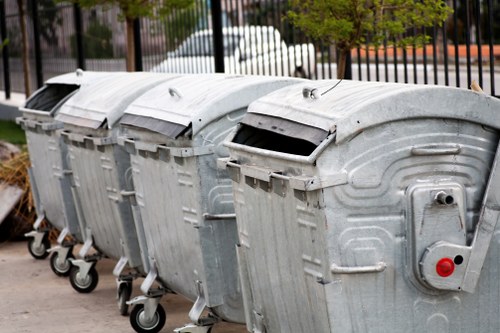Comprehensive Guide to Site Clearance in Hornsey

Site clearance is a critical first step in any construction or development project in Hornsey. It involves the removal of debris, vegetation, and existing structures to prepare the land for new construction. Proper site clearance ensures that the project proceeds smoothly, adhering to local regulations and environmental standards.
Hornsey, located in the vibrant London Borough of Haringey, presents unique challenges for site clearance. The area's rich history and diverse landscape require careful planning and execution to preserve its character while accommodating new developments.
Choosing the right site clearance service in Hornsey is essential for the success of your project. Experienced professionals understand the local regulations, environmental considerations, and logistical challenges, ensuring that the clearance process is efficient and compliant.

Why Site Clearance is Essential
Site clearance is not just about removing unwanted materials. It sets the foundation for a successful construction project by:
- Ensuring Safety: Removing hazardous materials and debris reduces risks for workers and future occupants.
- Compliance: Adhering to local regulations and environmental standards is crucial to avoid legal issues.
- Efficiency: A well-cleared site allows for smoother construction processes, saving time and resources.
- Environmental Protection: Proper clearance minimizes the impact on the surrounding environment, preserving local flora and fauna.
In Hornsey, where green spaces and historical sites are prevalent, responsible site clearance is particularly important to maintain the area's charm and ecological balance.

Steps Involved in Site Clearance
The site clearance process in Hornsey typically involves several key steps to ensure thorough and effective preparation:
- Site Assessment: Evaluating the site to identify existing structures, vegetation, and potential hazards.
- Planning: Developing a clearance plan that outlines the methods, equipment, and timeline.
- Permitting: Obtaining necessary permits from local authorities to comply with regulations.
- Debris Removal: Safely removing debris, old structures, and vegetation from the site.
- Soil Preparation: Ensuring the soil is suitable for construction by addressing contamination or instability issues.
- Final Inspection: Conducting a thorough inspection to confirm that the site is ready for the next phase of development.

Site Assessment and Planning
The initial phase of site clearance begins with a comprehensive site assessment. Professionals inspect the area to identify existing buildings, underground utilities, and natural features. This assessment is crucial for developing a detailed clearance plan that addresses all aspects of the site.
Planning involves selecting the appropriate machinery and techniques to efficiently clear the site. It also includes scheduling the work to minimize disruptions to the local community and environment.
In Hornsey, considerations such as proximity to residential areas, protected green spaces, and historical landmarks are integral to the planning process. Effective planning ensures that the clearance work aligns with the community's expectations and regulatory requirements.

Permitting and Compliance
Obtaining the necessary permits is a critical step in the site clearance process. In Hornsey, this involves coordinating with local authorities to secure approvals for the clearance work. Compliance with environmental regulations, building codes, and safety standards is mandatory to avoid legal complications.
Permits typically require detailed documentation of the clearance plan, including methods for debris disposal, dust control measures, and noise reduction strategies. Working with experienced site clearance services ensures that all paperwork is accurately completed and submitted on time.
Non-compliance can result in fines, project delays, or even the halt of construction activities. Therefore, adhering to permitting and compliance requirements is vital for the smooth progression of your project.

Environmental Considerations
Environmental protection is a significant concern during site clearance in Hornsey. Professionals must implement strategies to minimize the ecological footprint of the clearance process. This includes:
- Waste Management: Proper disposal and recycling of materials to reduce landfill usage.
- Habitat Preservation: Protecting local wildlife and plant species during clearance activities.
- Pollution Control: Using techniques to prevent soil erosion, water contamination, and air pollution.
- Sustainable Practices: Incorporating eco-friendly methods and materials to promote sustainability.
By prioritizing environmental considerations, site clearance services in Hornsey contribute to the preservation of the area's natural beauty and ecological integrity.

Choosing the Right Site Clearance Service
Selecting a reliable site clearance service in Hornsey is crucial for achieving the desired outcomes. Consider the following factors when making your choice:
- Experience: Look for companies with a proven track record in site clearance and construction projects.
- Licensing and Insurance: Ensure the service provider holds necessary licenses and insurance coverage.
- Local Knowledge: Familiarity with Hornsey's regulations, geography, and community is essential.
- Equipment and Technology: Advanced machinery and modern techniques enhance efficiency and safety.
- Reputation: Positive reviews and testimonials indicate reliability and quality of service.
- Cost: Obtain transparent pricing and ensure it aligns with your budget without compromising quality.
By evaluating these factors, you can select a site clearance service that meets your project’s specific needs and ensures a successful outcome.

Safety Measures
Safety is paramount during site clearance. Professionals implement comprehensive safety protocols to protect workers and the surrounding community. Key safety measures include:
- Personal Protective Equipment (PPE): Ensuring all workers wear appropriate gear such as helmets, gloves, and safety boots.
- Site Security: Restricting access to authorized personnel to prevent accidents and unauthorized interference.
- Hazard Identification: Regularly assessing the site for potential dangers and addressing them promptly.
- Emergency Procedures: Establishing clear protocols for handling accidents or unexpected incidents.
- Training: Providing ongoing safety training to all team members to maintain high safety standards.
In Hornsey, adherence to safety regulations not only ensures compliance but also fosters a secure working environment, reducing the risk of accidents and enhancing overall project efficiency.

Cost Factors in Site Clearance
The cost of site clearance in Hornsey can vary based on several factors. Understanding these elements helps in budgeting and selecting the right service provider:
- Site Size: Larger sites typically require more time and resources to clear, impacting the overall cost.
- Existing Structures: The presence of buildings, underground utilities, or hazardous materials can increase clearance expenses.
- Accessibility: Sites that are difficult to access may require specialized equipment or additional labor.
- Environmental Regulations: Compliance with environmental standards may involve extra steps, influencing the cost.
- Timeline: Projects with tight deadlines might incur higher costs due to the need for expedited services.
- Waste Disposal: Proper disposal and recycling of materials can affect the overall pricing.
Early assessment and clear communication with your site clearance provider can help manage costs effectively, ensuring your project remains within budget.

Budgeting for Site Clearance
Creating a realistic budget for site clearance involves considering all potential expenses. Start by obtaining detailed quotes from multiple service providers, ensuring that each quote includes all aspects of the clearance process. Compare these quotes to identify the best value without compromising on quality or compliance.
Additionally, account for unexpected costs such as delays due to weather, unforeseen hazards, or changes in project scope. Setting aside a contingency fund can provide financial flexibility to handle these surprises without derailing your project.
Effective budgeting also involves prioritizing essential services and identifying areas where cost savings can be achieved without sacrificing safety or compliance. Collaborating closely with your site clearance provider can help optimize your budget allocation.

Timeline for Site Clearance Projects
The duration of a site clearance project in Hornsey depends on various factors, including the site's size, complexity, and specific requirements. On average, small to medium-sized projects may take a few weeks, while larger or more intricate sites could require several months.
- Initial Assessment: 1-2 weeks for thorough site evaluation and planning.
- Permitting and Approvals: 2-4 weeks depending on local authority processing times.
- Actual Clearance Work: 4-12 weeks based on site size and complexity.
- Final Inspection: 1 week to ensure all clearance tasks are completed satisfactorily.
Effective project management and clear communication with your site clearance team can help adhere to the timeline, ensuring that subsequent construction phases commence as scheduled.

Delays and Mitigation Strategies
Delays in site clearance projects can arise from various sources, including adverse weather conditions, unexpected site hazards, or logistical challenges. Implementing mitigation strategies can minimize the impact of these delays:
- Flexible Scheduling: Allowing for adjustments in the project timeline to accommodate unforeseen changes.
- Contingency Planning: Preparing backup plans for potential obstacles, such as alternative disposal sites or additional workforce.
- Regular Monitoring: Continuously tracking project progress to identify and address delays promptly.
- Effective Communication: Maintaining open lines of communication with all stakeholders to manage expectations and coordinate responses to delays.
By proactively addressing potential delays, site clearance projects in Hornsey can maintain momentum and adhere to overall project schedules.

Post-Clearance Activities
Once site clearance is complete, several post-clearance activities ensure the site is fully prepared for construction:
- Soil Testing: Assessing soil quality and stability to determine suitability for building foundations.
- Land Grading: Leveling and shaping the land to facilitate construction and proper drainage.
- Utility Installation: Preparing spaces for plumbing, electrical systems, and other essential utilities.
- Final Inspection: Conducting a comprehensive review to confirm that all clearance and preparation tasks meet the required standards.
- Documentation: Compiling detailed reports and records of the clearance process for future reference and compliance purposes.
These activities ensure that the cleared site is ready for the subsequent stages of construction, laying a solid foundation for the successful realization of your project in Hornsey.

Soil Testing and Preparation
Soil testing is a crucial post-clearance activity that determines the suitability of the land for construction. It involves analyzing soil composition, density, and stability to identify any potential issues such as contamination or inadequate support for structures.
Based on the soil test results, necessary preparations can be made, including soil stabilization, remediation of contaminated areas, or selecting appropriate foundation types. Proper soil preparation ensures the longevity and safety of the constructed buildings.
In Hornsey, where soil conditions can vary, thorough testing and preparation are essential to address site-specific challenges and ensure that construction can proceed without foundational issues.

Environmental Sustainability in Site Clearance
Emphasizing environmental sustainability in site clearance is increasingly important in Hornsey. Sustainable practices not only protect the environment but also contribute to the long-term success of construction projects. Key sustainability initiatives include:
- Recycling and Reuse: Salvaging materials for reuse or recycling reduces waste and conserves resources.
- Minimizing Disturbance: Implementing techniques that minimize disruption to the local ecosystem and reduce carbon footprint.
- Energy-Efficient Equipment: Utilizing machinery and tools that consume less energy and produce fewer emissions.
- Green Waste Management: Properly handling and disposing of green waste to prevent environmental degradation.
- Collaborative Planning: Working with environmental experts to develop strategies that align with sustainability goals.
By integrating sustainable practices into site clearance, developers in Hornsey can promote environmental responsibility and enhance the overall value of their projects.

Recycling and Waste Management
Effective recycling and waste management are integral to sustainable site clearance. This involves segregating materials such as wood, metal, concrete, and green waste for appropriate disposal or repurposing. Recycling reduces the amount of waste sent to landfills and lowers the environmental impact of construction projects.
In Hornsey, partnering with local recycling facilities and waste management services ensures that materials are handled responsibly, adhering to both environmental regulations and community expectations.
Implementing comprehensive waste management plans enhances the sustainability of site clearance projects and supports the broader goals of reducing the construction industry's ecological footprint.

Community Engagement and Communication
Engaging with the local community is an essential aspect of site clearance in Hornsey. Transparent communication fosters trust and ensures that residents are informed about project activities, timelines, and potential impacts.
- Public Notices: Informing the community about upcoming clearance work through notices and announcements.
- Feedback Channels: Providing avenues for residents to voice concerns or provide input on the project.
- Regular Updates: Keeping the community informed about project progress and any changes to the schedule.
- Minimizing Disruption: Implementing measures to reduce noise, dust, and traffic disruptions during clearance activities.
- Community Benefits: Highlighting how the project will benefit the local area, such as creating new housing or improving infrastructure.
Effective community engagement ensures that site clearance projects are conducted smoothly, with minimal opposition and enhanced support from local residents.

Addressing Community Concerns
Addressing community concerns proactively is vital for maintaining positive relations during site clearance. Common concerns in Hornsey may include:
- Noise Pollution: Implementing noise control measures and scheduling work during appropriate hours.
- Dust and Air Quality: Using water sprays and other dust suppression techniques to maintain air quality.
- Traffic Management: Coordinating with local authorities to manage traffic flow and minimize congestion.
- Safety: Ensuring that the clearance site is secure and that there are no hazards for pedestrians and nearby residents.
- Aesthetic Impact: Maintaining the visual appeal of the site and surrounding areas during clearance activities.
By actively listening to and addressing these concerns, site clearance services can foster a cooperative environment, facilitating smoother project execution and greater community support.

Technological Advancements in Site Clearance
Technological advancements are transforming the site clearance industry in Hornsey, enhancing efficiency, safety, and environmental compliance. Key innovations include:
- Advanced Machinery: Utilizing state-of-the-art equipment that improves the speed and precision of clearance tasks.
- Digital Planning Tools: Employing software for site assessments, project management, and progress tracking.
- Remote Monitoring: Implementing sensors and cameras to monitor site conditions and ensure safety from a distance.
- Eco-Friendly Technologies: Adopting green technologies that reduce emissions and energy consumption during clearance operations.
- Automated Systems: Using robotics and automation to perform repetitive or hazardous tasks, enhancing worker safety.
These technological advancements enable site clearance services in Hornsey to deliver high-quality results more efficiently while maintaining strict adherence to safety and environmental standards.

Impact of Technology on Project Outcomes
The integration of technology in site clearance significantly impacts project outcomes by:
- Increasing Efficiency: Automation and advanced machinery speed up the clearance process, reducing project timelines.
- Enhancing Safety: Remote monitoring and automated systems minimize human exposure to hazardous conditions.
- Improving Accuracy: Digital planning tools ensure precise execution of clearance plans, reducing errors and rework.
- Reducing Environmental Impact: Eco-friendly technologies lower emissions and promote sustainable practices.
- Facilitating Communication: Digital platforms enable better collaboration and information sharing among project stakeholders.
Overall, technology plays a pivotal role in advancing the capabilities of site clearance services, leading to superior project outcomes and increased client satisfaction.

Regulatory Framework for Site Clearance in Hornsey
Site clearance in Hornsey operates within a comprehensive regulatory framework designed to ensure safety, environmental protection, and community well-being. Key regulations include:
- Building Regulations: Standards that govern the structural integrity and safety of buildings, influencing clearance activities.
- Environmental Protection Laws: Legislation aimed at preserving natural resources and minimizing environmental impact.
- Health and Safety Regulations: Guidelines that ensure the safety of workers and the public during clearance operations.
- Waste Management Policies: Rules governing the disposal and recycling of materials removed during site clearance.
- Planning Permissions: Approvals required for certain types of clearance activities and subsequent construction projects.
Compliance with these regulations is mandatory for all site clearance projects in Hornsey. Working with knowledgeable professionals ensures that your project adheres to the necessary legal standards, avoiding potential fines and delays.

Obtaining Necessary Permits
Securing the appropriate permits is a critical aspect of the site clearance process in Hornsey. This involves submitting detailed plans to local authorities, demonstrating how the clearance work will comply with regulatory requirements. Key permits may include:
- Demolition Permits: Required for the removal of existing structures.
- Environmental Permits: Needed for activities that may impact the environment, such as waste disposal or soil remediation.
- Noise Permits: Necessary if the clearance work involves operations that generate significant noise.
- Planning Permissions: Essential for certain types of developments and changes to land use following clearance.
Obtaining these permits involves thorough documentation and adherence to guidelines set by local authorities. Experienced site clearance services can assist in navigating the permitting process, ensuring all necessary approvals are in place before commencing work.

Case Studies: Successful Site Clearance Projects in Hornsey
Examining past site clearance projects in Hornsey provides valuable insights into best practices and successful strategies. Here are a few notable examples:
- Residential Development in Crouch End: This project involved clearing a derelict site for the construction of new housing units. The clearance team successfully managed the removal of old structures, recycling of materials, and preservation of surrounding green spaces.
- Commercial Complex in Harringay: A large-scale clearance project for a new commercial building required precise coordination to minimize disruption to the busy area. The team implemented effective traffic management and noise control measures, ensuring a smooth clearance process.
- Park Enhancement Project in Highgate: This environmentally sensitive clearance involved the removal of invasive species and restoration of native habitats. The project highlighted the importance of sustainable practices and community engagement.
These case studies demonstrate the versatility and expertise of site clearance services in Hornsey, capable of handling diverse projects with efficiency and compliance.

Lessons Learned from Previous Projects
Analyzing previous site clearance projects in Hornsey reveals key lessons that contribute to improved practices:
- Early Planning: Initiating comprehensive planning early in the project lifecycle ensures that potential challenges are addressed proactively.
- Stakeholder Collaboration: Engaging with all stakeholders, including local authorities and community members, fosters a cooperative environment and smooth project execution.
- Flexibility: Being adaptable to unexpected changes or obstacles allows for timely adjustments, maintaining project momentum.
- Continuous Monitoring: Regularly tracking project progress and compliance ensures that standards are maintained throughout the clearance process.
- Sustainability Focus: Prioritizing environmentally sustainable practices enhances project reputation and aligns with broader ecological goals.
Incorporating these lessons into future projects enhances the effectiveness and reliability of site clearance services in Hornsey.

Future Trends in Site Clearance
The site clearance industry in Hornsey is evolving, influenced by technological advancements, regulatory changes, and growing environmental awareness. Future trends include:
- Increased Automation: Automation and robotics will play a larger role in clearance activities, improving efficiency and safety.
- Green Clearance Practices: Sustainability will continue to drive the adoption of eco-friendly techniques and materials.
- Data-Driven Decision Making: Leveraging big data and analytics to optimize clearance strategies and resource allocation.
- Enhanced Community Engagement: Greater emphasis on transparent communication and collaboration with local communities.
- Regulatory Adaptations: Evolving laws and standards will shape clearance practices, emphasizing compliance and environmental stewardship.
Staying abreast of these trends enables site clearance services in Hornsey to remain competitive, innovative, and aligned with industry best practices.

Adoption of Sustainable Technologies
As environmental concerns grow, site clearance companies in Hornsey are increasingly adopting sustainable technologies. These include energy-efficient machinery, renewable energy sources for operations, and advanced waste sorting systems that enhance recycling rates.
Implementing these technologies not only reduces environmental impact but also enhances operational efficiency and cost-effectiveness, positioning companies as leaders in sustainable site clearance.
Clients increasingly prefer working with environmentally responsible service providers, making sustainability a key differentiator in the market.

Conclusion
Site clearance in Hornsey is a multifaceted process that requires careful planning, expertise, and adherence to regulatory standards. It serves as the foundational step for successful construction and development projects, ensuring safety, compliance, and environmental responsibility.
By choosing experienced and reliable site clearance services, engaging with the community, and embracing sustainable practices, developers can navigate the complexities of site clearance with confidence. As the industry evolves with technological advancements and growing environmental awareness, staying informed and adaptable will be key to achieving outstanding project outcomes in Hornsey.
Ready to start your project? Contact us today to book your site clearance service in Hornsey and take the first step towards a successful development.